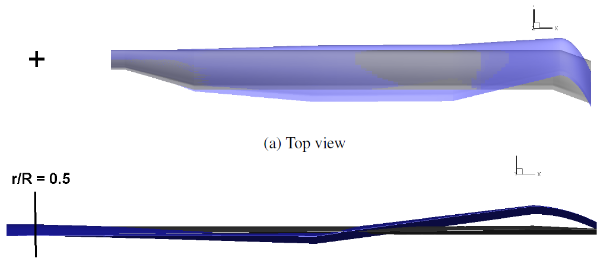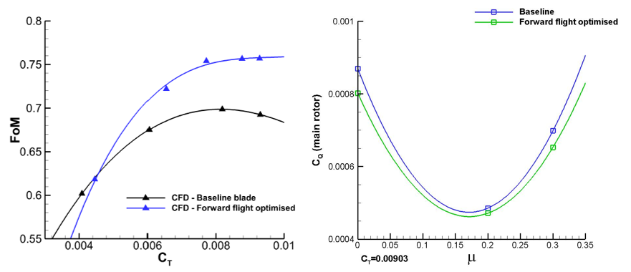Advanced Rotor Blade Design
Helicopters are complex, unique machines that serve many roles in the modern world and are present in the military, civilian, medicine and fire-fighting duties. Improvements in the aerodynamic design of the helicopter, main rotor blade in particular, can lead to reduced fuel burn and flight envelope expansion. The variety of designs used in industry shows that the exact optimum rotor design is still unknown. The multi-disciplinarity of rotor blade design poses a significant challenge, as aspects such as aerodynamics, dynamics, vibration, acoustics, aeroelasticity and structural design must all be considered.
To tackle some of the challenges of rotor design, a collaboration project was formed under The Technical Cooperation Programme (TTCP) labelled as Advanced Rotor Blade Design with participants from UK (DSTL, University of Glasgow), USA (US Army), Australia (DSTO) and Canada (NRC). The project aimed to compare the rotor design tools of the different partners and use these tools to develop and demonstrate more optimal rotor designs.
Computational Method:
Due to fast turn-around times, low fidelity methods are still widely used in industry today for rotor blade design. These methods are often labelled as comprehensive rotor codes and are based on blade element momentum theory, a wake model, and two-dimensional aerodynamics. They do not capture highly three-dimensional phenomena such as tip vortex formation and roll-up which can have a large impact on the rotor blade loading, and hence, performance. The high computational costs of fully-resolved time-accurate Navier-Stokes CFD simulations, make them unsuitable for industrial rotor design. However, to further the current state of the art in aerodynamic rotor design, high fidelity methods must be adopted.
To reduce the computational costs whilst maintaining the fidelity of the Navier Stokes equations, an optimisation framework based on the adjoint harmonic balance method was developed. The nature of the harmonic balance method recasts an unsteady flowfield as a large steady-state problem by assuming periodicity in time. This allows for coupling with a steady adjoint method, used for efficient computation of all the design sensitivities at the cost of a base flow solution.
Results:
The optimisation framework was applied to the the AH-64A blade in forward flight at moderate advance ratio (0.3) and high loading conditions (Ct = 0.00903) with design variables including rotor blade twist, chord, sweep and anhedral. The optimisation process leads to a rotor blade with an offloaded blade tip (reduced blade tip area, increased blade twist), a forward-backward sweep distribution and a dihedral-anhedral planform shape. These design features lead to a more uniform disk loading, a weakening of the blade tip vortices, reduced strength of the advancing blade shockwave and improved loading on the retreating side, leading to significant performance benefits in both hover and forward flight.
Future Work:
Further work focuses on improving the fidelity of the optimisation framework by including aeroelastic effects. The HMB3 solver has recently been coupled with NASTRAN for coupled CFD/CSD analyses, which will be included within the harmonic balance adjoint framework. Further work also concerns rotor trim considerations during the optimisation process, the use of a more advanced blade surface parameterisation and improvements in the efficiency of the adjoint solver.
Contact:
George Barakos - George.Barakos@glasgow.ac.uk
Thomas Fitzgibbon (PhD student) - thomas.fitzgibbon@glasgow.ac.uk
Publications:
Fitzgibbon, T., Barakos, G., and Woodgate, M., "Validation of the Steady State Hover Formulation for Accurate Performance Predictions," AIAA Journal, Vol. 57, No. 12, 2019, pp. 5293-5308, DOI: 10.2514/1.J058408
Fitzgibbon, T., Barakos, G., and Woodgate, M., "Assessment of current rotor design comparison practices based on high-fidelity CFD methods," The Aeronautical Journal, Vol. 124, No. 1275, 2020, pp. 731-766, DOI:10.1017/aer.2019.162
Barakos, G.N., Fitzgibbon, T., Kusyumov, A.N., Kusyumon, S.A. and Mikhailov, S.A., "CFD simulation of helicopter rotor flow based on unsteady actuator disk model," Chinese Journal of Aeronautics, 2020, DOI:: 10.1016/j.cja.2020.03.021
Fitzgibbon, T., Barakos, G., Woodgate, M., and Jimenez-Garcia, A., "Numerical Simulation of Different Rotor Designs in Hover and Forward Flight," Proceedings of the 44th European Rotorcraft Forum, 18-21 September 2018, Delft, Netherlands.
Fitzgibbon, T., Barakos, G., Woodgate, M., and Jimenez-Garcia, A., "Numerical Simulation of Various Rotor Designs in Hover and Forward Flight," Proceedings of the 2019 SciTech AIAA Forum, 7-11 January 2019, San Diego, CA, USA.
Fitzgibbon, T., Barakos, G., and Woodgate, M., "Assessment of current CFD performance prediction capabilities for novel rotor blade planforms," Proceedings of the 75th Annual Forum of the American Helicopter Society, 13-16 May 2019, Philadelphia, USA.
Fitzgibbon, T., Barakos, G., and Woodgate, M., "Assessment of the Harmonic Balance Method for Rotor Blade Performance Predictions," Proceedings of the 45th European Rotorcraft Forum,17-19 September 2019, Warsaw, Poland.
Lim, J., Jain, R., Potsdam, M., Widjaja, R., Barakos, G., and Fitzgibbon, T., "High Fidelity Code-to-Code Comparison of Rotor Performance Predictions for Hover and Forward Flight," 76th Annual Forum of the American Helicopter Society, 6-8th October 2020, Virginia Beach, USA.




